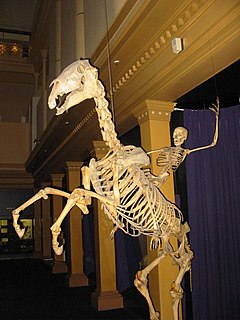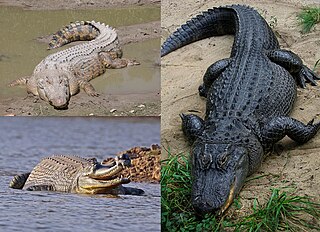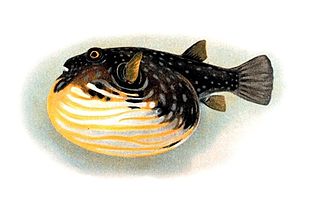
Anatomy is the branch of biology concerned with the study of the structure of organisms and their parts. Anatomy is a branch of natural science which deals with the structural organization of living things. It is an old science, having its beginnings in prehistoric times. Anatomy is inherently tied to developmental biology, embryology, comparative anatomy, evolutionary biology, and phylogeny, as these are the processes by which anatomy is generated, both over immediate and long-term timescales. Anatomy and physiology, which study the structure and function of organisms and their parts respectively, make a natural pair of related disciplines, and are often studied together. Human anatomy is one of the essential basic sciences that are applied in medicine.

Warm-blooded is an informal term referring to animal species which can maintain a body temperature higher than their environment. In particular, homeothermic species maintain a stable body temperature by regulating metabolic processes. The only known living homeotherms are birds and mammals, and the only living homeothermic lizard is the Argentine black and white tegu. Some extinct reptiles such as ichthyosaurs, pterosaurs, plesiosaurs and some non-avian dinosaurs are believed to have been homeotherms. Other species have various degrees of thermoregulation.

Reptiles, as most commonly defined, are the animals in the class Reptilia, a paraphyletic grouping comprising all sauropsid amniotes except Aves (birds). Living reptiles comprise turtles, crocodilians, squamates and rhynchocephalians (tuatara). As of March 2022, the Reptile Database lists about the class includes about 11,700 species. In the traditional Linnaean classification system, birds are considered a separate class to reptiles. However, crocodilians are more closely related to birds than they are to other living reptiles, and so modern cladistic classification systems include birds within Reptilia, redefining the term as a clade. Other cladistic definitions abandon the term reptile altogether in favor of the clade Sauropsida, which refers to all amniotes more closely related to modern reptiles than to mammals. The study of the traditional reptile orders, historically combined with that of modern amphibians, is called herpetology.

A skeleton is a structural frame that supports an animal body. There are several different skeletal types: the exoskeleton, which is the stable outer shell of an organism, the endoskeleton, which forms the support structure inside the body, and the hydroskeleton, a flexible skeleton supported by fluid pressure. The term comes from Ancient Greek σκελετός (skeletós) 'dried up'.

The heart is a muscular organ in most animals that pumps blood through the blood vessels of the circulatory system. The pumped blood carries oxygen and nutrients to the body, while carrying metabolic waste such as carbon dioxide to the lungs. In humans, the heart is approximately the size of a closed fist and is located between the lungs, in the middle compartment of the chest.

The blood circulatory system, is a system of organs that includes the heart, blood vessels, and blood which is circulated throughout the entire body of a human or other vertebrate. It includes the cardiovascular system, or vascular system, that consists of the heart and blood vessels. The circulatory system has two divisions, a systemic circulation or circuit, and a pulmonary circulation or circuit. Some sources use the terms cardiovascular system and vascular system interchangeably with the circulatory system.

The respiratory system is a biological system consisting of specific organs and structures used for gas exchange in animals and plants. The anatomy and physiology that make this happen varies greatly, depending on the size of the organism, the environment in which it lives and its evolutionary history. In land animals the respiratory surface is internalized as linings of the lungs. Gas exchange in the lungs occurs in millions of small air sacs; in mammals and reptiles these are called alveoli, and in birds they are known as atria. These microscopic air sacs have a very rich blood supply, thus bringing the air into close contact with the blood. These air sacs communicate with the external environment via a system of airways, or hollow tubes, of which the largest is the trachea, which branches in the middle of the chest into the two main bronchi. These enter the lungs where they branch into progressively narrower secondary and tertiary bronchi that branch into numerous smaller tubes, the bronchioles. In birds the bronchioles are termed parabronchi. It is the bronchioles, or parabronchi that generally open into the microscopic alveoli in mammals and atria in birds. Air has to be pumped from the environment into the alveoli or atria by the process of breathing which involves the muscles of respiration.

Crocodilia is an order of mostly large, predatory, semiaquatic reptiles, known as crocodilians. They first appeared 95 million years ago in the Late Cretaceous period and are the closest living relatives of birds, as the two groups are the only known survivors of the Archosauria. Members of the order's total group, the clade Pseudosuchia, appeared about 250 million years ago in the Early Triassic period, and diversified during the Mesozoic era. The order Crocodilia includes the true crocodiles, the alligators and caimans, and the gharial and false gharial. Although the term 'crocodiles' is sometimes used to refer to all of these, crocodilians is a less ambiguous vernacular term for members of this group.

An endotherm is an organism that maintains its body at a metabolically favorable temperature, largely by the use of heat released by its internal bodily functions instead of relying almost purely on ambient heat. Such internally generated heat is mainly an incidental product of the animal's routine metabolism, but under conditions of excessive cold or low activity an endotherm might apply special mechanisms adapted specifically to heat production. Examples include special-function muscular exertion such as shivering, and uncoupled oxidative metabolism, such as within brown adipose tissue. Only birds and mammals are extant universally endothermic groups of animals. Certain Argentine black and white tegu, lamnid sharks, tuna and billfishes are also endothermic.

An ectotherm is an organism in which internal physiological sources of heat are of relatively small or of quite negligible importance in controlling body temperature. Such organisms rely on environmental heat sources, which permit them to operate at very economical metabolic rates.

Aquatic respiration is the process whereby an aquatic organism exchanges respiratory gases with water, obtaining oxygen from oxygen dissolved in water and excreting carbon dioxide and some other metabolic waste products into the water.

Archosauria is a clade of diapsids, with birds and crocodilians as the only living representatives. Archosaurs are broadly classified as reptiles, in the cladistic sense of term which includes birds. Extinct archosaurs include non-avian dinosaurs, pterosaurs, and extinct relatives of crocodilians. Modern paleontologists define Archosauria as a crown group that includes the most recent common ancestor of living birds and crocodilians, and all of its descendants. The base of Archosauria splits into two clades: Pseudosuchia, which includes crocodilians and their extinct relatives, and Avemetatarsalia, which includes birds and their extinct relatives.

Allometry is the study of the relationship of body size to shape, anatomy, physiology and finally behaviour, first outlined by Otto Snell in 1892, by D'Arcy Thompson in 1917 in On Growth and Form and by Julian Huxley in 1932.

Gigantothermy is a phenomenon with significance in biology and paleontology, whereby large, bulky ectothermic animals are more easily able to maintain a constant, relatively high body temperature than smaller animals by virtue of their smaller surface-area-to-volume ratio. A bigger animal has proportionately less of its body close to the outside environment than a smaller animal of otherwise similar shape, and so it gains heat from, or loses heat to, the environment much more slowly.

A poikilotherm is an animal whose internal temperature varies considerably. Poikilotherms have to survive and adapt to environmental stress. One of the most important stressors is temperature change, which can lead to alterations in membrane lipid order and can cause protein unfolding and denaturation at elevated temperatures. It is the opposite of a homeotherm, an animal which maintains thermal homeostasis. While the term in principle can apply to all organisms, it is generally only applied to animals, and mostly to vertebrates. Usually the fluctuations are consequence of variation in the ambient environmental temperature. Many terrestrial ectotherms are poikilothermic. However some ectotherms remain in temperature-constant environments to the point that they are actually able to maintain a constant internal temperature .It is this distinction that often makes the term "poikilotherm" more useful than the vernacular "cold-blooded", which is sometimes used to refer to ectotherms more generally.

The southern bluefin tuna is a tuna of the family Scombridae found in open southern Hemisphere waters of all the world's oceans mainly between 30°S and 50°S, to nearly 60°S. At up to 2.5 metres and weighing up to 260 kilograms (570 lb), it is among the larger bony fishes.
The physiology of dinosaurs has historically been a controversial subject, particularly their thermoregulation. Recently, many new lines of evidence have been brought to bear on dinosaur physiology generally, including not only metabolic systems and thermoregulation, but on respiratory and cardiovascular systems as well.

Insect thermoregulation is the process whereby insects maintain body temperatures within certain boundaries. Insects have traditionally been considered as poikilotherms as opposed to being homeothermic. However, the term temperature regulation, or thermoregulation, is currently used to describe the ability of insects and other animals to maintain a stable temperature, at least in a portion of their bodies by physiological or behavioral means. While many insects are ectotherms, others are endotherms. These endothermic insects are better described as regional heterotherms because they are not uniformly endothermic. When heat is being produced, different temperatures are maintained in different parts of their bodies, for example, moths generate heat in their thorax prior to flight but the abdomen remains relatively cool.

Fish physiology is the scientific study of how the component parts of fish function together in the living fish. It can be contrasted with fish anatomy, which is the study of the form or morphology of fishes. In practice, fish anatomy and physiology complement each other, the former dealing with the structure of a fish, its organs or component parts and how they are put together, such as might be observed on the dissecting table or under the microscope, and the later dealing with how those components function together in the living fish. For this, at first we need to know about their intestinal morphology.
The physiology of underwater diving is the physiological adaptations to diving of air-breathing vertebrates that have returned to the ocean from terrestrial lineages. They are a diverse group that include sea snakes, sea turtles, the marine iguana, saltwater crocodiles, penguins, pinnipeds, cetaceans, sea otters, manatees and dugongs. All known diving vertebrates dive to feed, and the extent of the diving in terms of depth and duration are influenced by feeding strategies, but also, in some cases, with predator avoidance. Diving behaviour is inextricably linked with the physiological adaptations for diving and often the behaviour leads to an investigation of the physiology that makes the behaviour possible, so they are considered together where possible. Most diving vertebrates make relatively short shallow dives. Sea snakes, crocodiles, and marine iguanas only dive in inshore waters and seldom dive deeper than 10 m. Some of these groups can make much deeper and longer dives. Emperor penguins regularly dive to depths of 400 to 500 m for 4 to 5 minutes, often dive for 8 to 12 minutes, and have a maximum endurance of about 22 minutes. Elephant seals stay at sea for between 2 and 8 months and dive continuously, spending 90% of their time underwater and averaging 20 minutes per dive with less than 3 minutes at the surface between dives. Their maximum dive duration is about 2 hours and they routinely feed at depths between 300 and 600 m, though they can exceed depths of 1600 m. Beaked whales have been found to routinely dive to forage at depths between 835 and 1070 m, and remain submerged for about 50 minutes. Their maximum recorded depth is 1888 m, and the maximum duration is 85 minutes.














